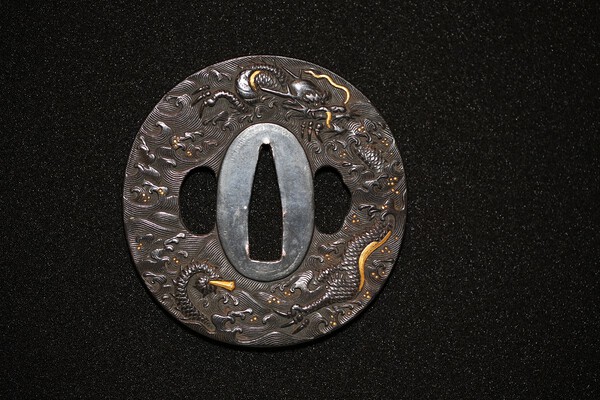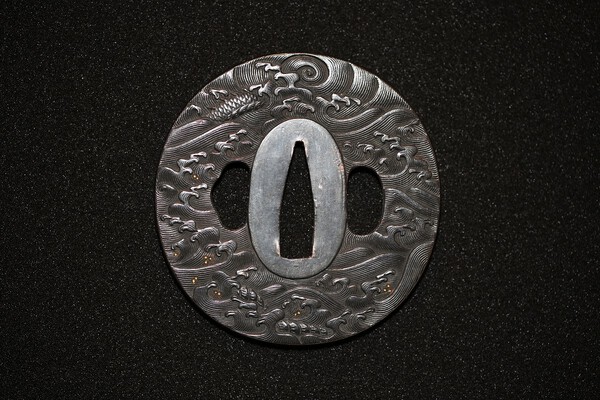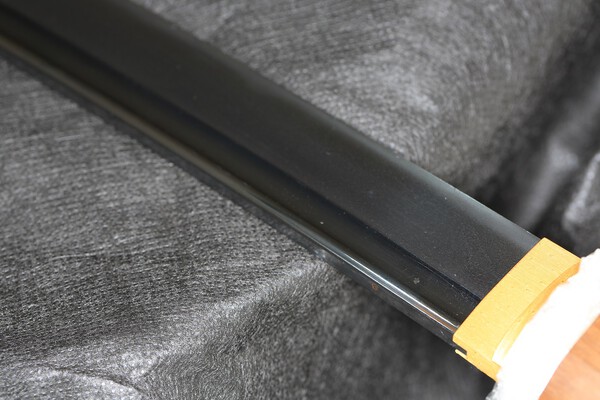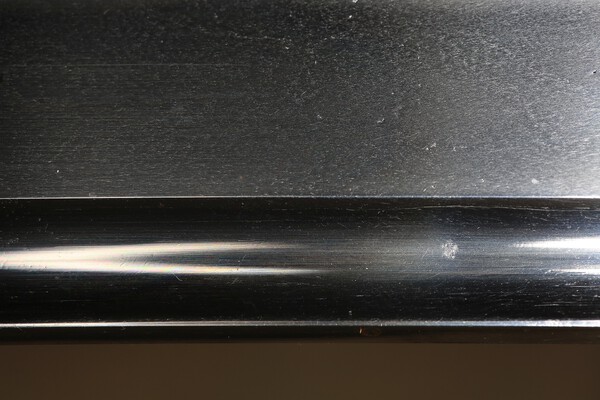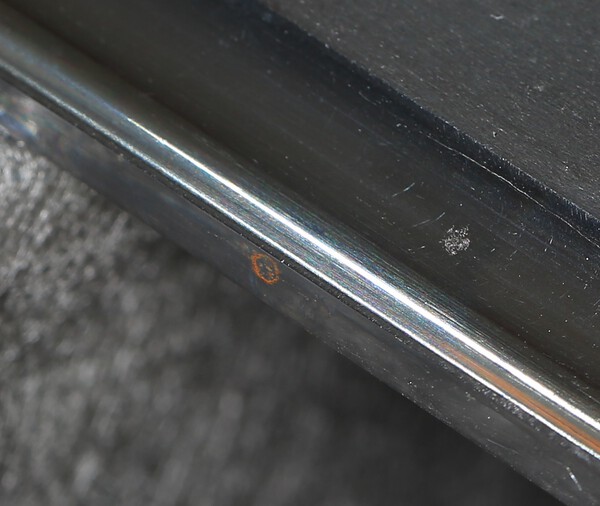-
Posts
116 -
Joined
-
Last visited
Content Type
Profiles
Forums
Events
Store
Downloads
Gallery
Everything posted by Loco Al
-
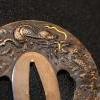
How Important is Provenance?
Loco Al replied to Loco Al's topic in General Nihonto Related Discussion
Named sword - is it possible that the juyo-bunkazai Tachi „Ima-Aranami-Ichimonji“ has a double? nihonto.com has for sale a JuTo Tachi also named „Ima Aranami Ichimonji“ ex Kitsuregawa Daimyo family. In the description: This blade is also referenced In Junji Honma‘s publication, Nihon Koto Shi. It can be found in Chapter 19 which was published in the NBTHK‘s Token Bijutsu No. 566, page 24. pic 1 - the Juyo Bunkazai blade, 69.1 cm, is illustrated in the german book Nihon-koto-shi page 95 (translated by Markus Sesko) pic 2 - the JuTo blade from nihonto.com, 68.5 cm These are two different swords, bearing the same name. Eric Hmm, very interesting! The Ima Aranami Ichimonji that I was referring to is the one shown on Nihonto.com, Fred Weissberg's site. Will the real Ima Aranami please step forward! I suppose it is possible that two old houses coincidentally chose the same name for one of their prized swords, without knowledge of the other existing. After all, it was probably just a name given to a sword. Not a title that was conferred by an organization like the NBTHK. It does make you wonder about the accuracy of some of the provenances given. Unproven family legends (as Rich said), and perhaps even the NBTHK can't keep all of it straight. Searching for old documents that say such-and-such owned it once upon a time, and who knows if those old records were faithful. I wouldn't doubt that there were many old fabrications made regarding the history of a sword. Alan -

How Important is Provenance?
Loco Al replied to Loco Al's topic in General Nihonto Related Discussion
Yes, I suppose that's it. Personal preference first. If the look of a particular blade appeals to you most, then that's the one to have. Provenance would be secondary. I guess there is no need to be coy about it. The Juyo blade with provenance is the Ima Aranami Ichimonji (Fukuoka) on Fred Weissberg's website. The blade he sold was a Tokubetsu Juyo Ichimonji (no longer on the website) which had great utsuri and a bo-hi. I am not sure which blade Kurt K. is referring to (perhaps he will enlighten us), but there was a Shizu Kaneuji for sale recently on Darcy Brockbank's website which was supposed to have belonged to Prince Takamatsu. He did say that there were no documents to confirm that part of it's history, though. It has been sold. Alan -
How important is provenance with regard to the decision to purchase a Koto blade (usually these are Juyo or above), and is it reflected in the price? I realise that a blade should stand on it's own merits, but does a good provenance (belonged to such-and-such a Daimyo or clan) make it any more desirable or collectable? Shouldn't this make it more saleable in the future? As an example: One website that I return to periodically, just to drool over the Juyo offerings and torture myself, had two similarly priced Juyo blades for sale. One of those blades has an excellent provenance, is Juyo, and has a signature (character "Ichi"). It has been sitting unsold for quite a while. The other blade was put up on that website just last year. It was mu-mei Tokobetsu Juyo, but had no special provenance (as I recall). It sold in relatively short order. I thought that the signed Juyo blade was actually the more interesting of the two, and I think has a more interesting hamon. Probably could pass TokuJu as well. Why did the buyer choose to ignore the Juyo blade with provenance, and instead snap up the TokuJu blade? To each his own, of course. Perhaps he just preferred the sugata (it also had bo-hi) and the fact that it was already TokoJu. Perhaps the Juyo blade is not as good as I think (to my relatively untrained eye), but that is where my money would have gone (if I had it). So provenance be damned? Alan
-
This thread has deteriorated most preposterously, but it is very entertaining! I think that was very well said, Chris. I think that that was intended to be an insult, but probably lost some clarity in translation. I always cheer up immensely if an attack is particularly wounding because I think, well, if they attack one personally, it means they have not a single political argument left. (Margaret Thatcher) Alan
-
Ah yes, that explains it! I think that I finally got that sports car thing out of my system a while ago. Sold my last great german sports car a year ago. Now I just drive a truck. Makes me sick to think how much money I wasted flipping cars over the last two decades. I have only two nice Nihonto. I hope that they will at least hold their value, and maybe even increase in value over the next ten to twenty years. That would be a bonus, but I won't count on it. Since you say that most of your swords are in the 2G range, then at least it won't hurt so bad if you have to take a bit of a loss one day. Wouldn't be so devastating as taking a big hit on a pricey Juyo sword. But as long as one stays within one's budget and has fun, that's the most important thing. That's how I rationalized the depreciation of my former sports cars. Hope I didn't ruffle your feathers with my first reply. Alan
-
Can I interest anyone in a couple of paintings? Need money to buy a Go Yoshihiro. Alan
-
Brian, you may have sparked an interesting debate. What I would like to know is: Where does this notion come from that there are people buying, or "investing" in, nihonto who are solely interested in making a profit (other than sword dealers, of course)? I suspect that you may be generalizing, and that there are very few who would actually consider a nihonto purchase purely motivated by profit. Who are these people? Can you give examples? Please forgive what follows, because I am going to take the mick out of you. I suspect that you may just be suffering from cabin fever and really should deserve more compassion. Anyway, your opening post sounds like the self-pitying ramblings of an old man (snowbound and nursing a bottle of single malt) who has an attic full of ho-hum un-papered old blades and has finally come to the realization that he may never be able to sell them. If he can sell them, he will have to take a loss because the well-informed moneyed buyers are looking for papered blades (preferably something unique or rare) in excellent condition as a hedge against taking a future loss themselves. Also because those blades may bring greater satisfaction. I certainly see no evidence that prices are being pushed up by a wave of new collectors looking for only the best. If anything prices have gone down and there are some "bargains" to be had, if you haven't already spent all your money on speculative un-papered blades. Of course everyone buys their first blade out of curiosity. You said: It got me to thinking that perhaps many of the new folks on the market are certainly appreciative of Nihonto but have more money than knowledge. I am sure that could be said of almost everyone who buys their first blade, no matter how cheap. If they get hooked, then they decided to start studying and learning (hopefully). If they are lucky and they had some guidance, then their first blade might be a good one. If not, then they chalk it up to experience and write off the loss. As I said before, I think the notion that someone would buy a nihonto as an investment is ridiculous. If they were really considering art as an investment, then they would be looking at something more mainstream like paintings by Canadian masters (if they live in Canada) for example. Nihonto collectors are a niche market, and I fear that we are considered to be somewhat peculiar by most mainstream art investors. Until this perception changes and more people become interested in acquiring Nihonto, then you may be stuck with those old swords. There are too few interested. This might prompt me to spin off a whole new topic, perhaps deserving of it's own thread: The liquidity conundrum. How much is too much to spend on a sword, lest the market is not there when you decide to sell it one day. Again, relatively too few buyers in the rarified atmosphere of Juyo and above. Those who can afford have an abundance of choice, and can afford to be very picky. Alan in Canada
-
"I have enough money to last me the rest of my life, unless I buy something." (Jackie Mason) I am not sure that you are being fair to new ( still relatively naïve and insecure) collectors who have more than just a few pennies to rub together. I do agree that Nihonto are likely not a good investment, especially in the present climate (pun intended). I can't imagine that even the most novice collector would assume that a Nihonto is a monetary investment for the future. It's an investment for the sake of preservation and appreciation. Alan
-
My aim is to start a thread about intimate sword photography. I'm an amateur who has the photography "bug". I'm not a pro. I have been envious, as I am sure many of you are, of the photos of swords on commercial websites. Not just envious of the swords themselves, but of the quality of the photos in which they seem to have magically captured detail in the hamon which often eludes amateur photographic attempts. Some websites are more accomplished than others with regard to producing lustful photos that really show off the activity in the hamon, and some have their own unique style. I'm not talking about the clinical looking, large format, photos which show both sides of the sword full length. Those likely require more specialized equipment or scanners to produce. With regard to the more creative style of photos, I have seen it said at least once on this forum: I wish I could take photos like that! The truth is, you probably can. The ability to take good photos of a sword need not be the sole purvey of the professionals. You don't need a lot of expensive equipment (fancy lights, soft-light boxes, etc.), unless you're really serious. All you preferably need is a DSLR camera, but I'm sure you can produce nice results with a point and shoot camera as well. Someone recently tried to start a thread with the title: hamons and hada pictures of nmb members. He was asking members to share photos of their own swords' hamons. He was politely directed to some links of popular commercial websites, where he might indulge himself. I thought his request was somewhat unreasonable myself, since not all members may wish to divulge what swords they have and share photos of same. But even if you did wish to share such photos, perhaps you feel you don't have the equipment or the ability necessary. The trick to capturing the hamon is all about light and angles, not expensive equipment. You have to be prepared to experiment a bit, and take lots of photos. What better way to truly admire and appreciate your sword. What follows is an avalanche of photos of a photogenic candidate I found hiding in the closet. An Ichimonji. The camera is a Canon DSLR. Some were taken with a 100mm lens and some with a 24 - 105 zoom lens. For some of the photos I also used a polarizing filter to help cut glare, but that is not necessary. A tripod is a must, as is manual focus. The room lights were off. The fancy "studio light" was nothing more than a 500 Watt Stanley work light. The seductive black fabric background was a plastic landscaping fabric. For the orange looking photo I had used a flash bounced off the ceiling in addition to the work light. The photo that looks a bit black-and-white was an experimental infrared photo (not so exciting). I may post a picture of my pathetic "studio" and the light set-up later. As I learn more from experimentation, I am happy to share my knowledge with you. Please also share your photographic tips and tricks with me. Perhaps we might have a section dedicated to photographic technique one day. Alan
-
If you're not going to tell us what this sword is, then may I kick this off by guessing and perhaps making a major fool of myself? Would three guesses (quick-pick attributions) be fair? Awataguchi (? Awataguchi Norikuni). At first I was going to say Rai Kunimitsu. No that would be too "common", and you had just mentioned that Awataguchi was your favourite school. My third guess would be a Bizen Kunimune. I'm too unqualified to fully qualify my guesses. My favourite "school" (so far): Ichimonji. Era: Kamakura. Smith: none If I had that Hasebe (in previous photo), I would nickname it The Leopard. Alan
-
Corrosion from a tiny blob of spittle! Surely not of my own origin! Yes, I guess that I have been busted for being a bit of an alarmist. I did say that it was small. Perhaps not good to take close-up (macro) photos of blades. Tends to reveal many small imperfections that you would rather not be aware of. Alan
-
You had me worried there for a minute , Ben. Cripes, my sword has cancer! It does look like a rusty line in the photo. No, that must be a reflection or photographic artifact showing in the hi. I looked at the hi with a magnifying glass and even took a few more close-up photos to study by zooming in. I can't see any rust in the hi. I'll be keeping a close eye on it, though. Alan
-
Thanks to all for your replies and advice. Adam asked if it looks like an umegane. I don't think that it is, but it does look like there is a tiny depression there. Perhaps a small flaw that might permit corrosion below the surface, which would worry me. The picture is magnified quite a bit, so it really is quite small. I may post another pic after I attempt to remove the rust. Alan
-
Small rust circle on mune which I just found today. Steel wool and Rustoleum (just kidding), or just oil frequently and hope it doesn't grow larger? Alan
-
Hard to tell from the photos (camera lenses may tend to distort things a bit), but sword looks relatively short. Possibly a wakizashi. Good polish. Hamon is relatively straight (suguha, tending towards notare). Chu-kissaki. Again, hard to tell from the photos, but nakago looks well rusted and possibly pitted. Need better photos of nakago. Hada, possibly itame or konuka. Guessing Edo period wakizashi. Hard to see much in the way of "pit marks". Possibly just a few small kitae-ware, which are really not considered a big deal. That's about the extent of my limited knowledge. Alan
-
O.K., here's some photos of the koshirae and the menuki. Just a simple black lacquer saya. Menuki are not so easy to photograph behind the thick laces. The close-ups reveal a lot of dirt. Alan
-
I also wondered if it might be iron. On the worn inside edge of the nakago-ani (where there is no patina) it looks like copper. It feels heavy and it is non-magnetic. The incandescent light that I used for the photos casts a bit of a golden glow and makes it look like there are some rusty areas between the waves. I'm pretty sure that it is shakudo. Alan
-
Hello Gentlemen, I recently acquired a sword that luckily came with koshirae. I really like the tsuba (and the menuki). I am told that it is a black dragon motif, but I wonder if it may be meant to represent some sort of sea monster instead. The menuki are half covered by doeskin lacing, so it is hard to tell what they truly represent. Possibly a 1700's (Edo period) work? I took a number of photos of the tsuba. Photography is one of my hobbies, so I just had to share these. Later I can upload some photos of the menuki and the whole koshirae, if you like. Alan


